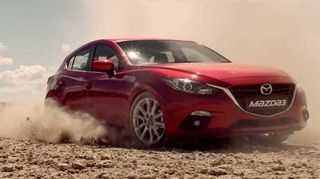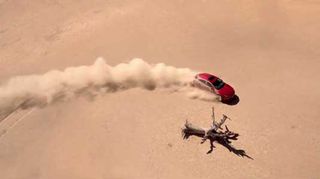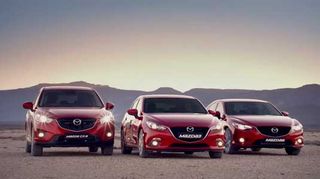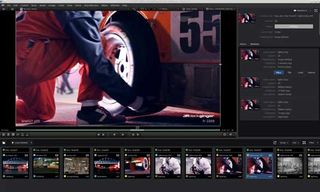BlackGinger travels back through time in nostalgic Mazda campaign
The team used ftrack, Nuke and Modo to bring the history of Mazda to life.
BlackGinger resides in Cape Town, South Africa, with the animation and VFX studio handling projects on both a local and international scale for the movie, TV and commercial industries.
Partnering with brands like Heinz, Ribena and Johnnie Walker for numerous projects, the studio recently worked with Mazda to produce a commercial looking all the way back through the automotive company's history and the Mazda 3 brand. A project for such a well-known company required a deft touch.
With all that history came a lot of research: 95 years in business is a long time for anything, but especially in an industry dealing with such rapid advancements as the automotive one.
Darrin Hofmeyr, animation supervisor, explains: "Much research went into recreating every aspect of classic cars that are no longer available, namely the Le Mans winner and the three-wheeled Mazdago. We took great care to match the CG cars to the originals."
But it wasn't just the cars that needed attention. The locations these vehicles were driving through needed to be as accurate as they could to help tell the story of Mazda. This involved a mix of physical sets, matte paintings and stock footage to create the required illusion.
With a lot of work needing to be done, it was crucial BlackGinger could manage its large team efficiently and communicate across multiple departments effectively. The use of ftrack in the Mazda project meant it was trouble-free and direct when it came to production management.

"Fine details of the schedule had to be planned well in advance and agreed to by all parties," Hofmeyr explained. "To this end, ftrack's notifications kept artists up to date with any changes to the live action footage, to the edit and the directors' notes. Everyone had instant access to updates."
Efficient, flowing communication
But it went further than just being used for notifying people of changes: "Review processes required tight turnaround times too," Hofmeyr says. "Our VFX supervisor was able to check, comment on and approve pre comps and versions directly and immediately in ftrack."
The main reason why the project was so demanding of efficient, flowing communication was down to its complexity. The aforementioned different types of shots mixed together meant a lot of work on film, animation, CG and other areas.
BlackGinger's pipeline uses a wide range of tools, each playing a key part in getting specific areas of the job done. For the Mazda job the studio used Nuke as the backbone, calling on Houdini for effects, SoftImage and Modo for modelling as well as Mari and Photoshop for texturing and finishing.

Once the commercial was in its final stages of post-production, there was still a lot to do as Hofmeyr explained: "We introduced film and video textures and artefacts that accurately represented the look and feel of archival footage.
Whether it was adding film grain, video ghosting or archival ageing, we worked to strike a careful balance to make the resulting commercial feel seamless and authentic."
When it came to working on the CG vehicles, things had to be photorealistic from every angle, meaning a crucial modelling and texturing phase to create a strong platform for lighting and shading artists.
Getting ready for the closeups
"Since we didn't have the real car to photograph, finding detailed references was a big challenge," Hofmeyr says. "We had to rely on schematics and images found online.
"In the end, we were literally modelling nuts and bolts. Even the windscreen wiper had all of its clips and mechanisms in fine detail. Fortunately we use Modo as our modelling weapon of choice. Its substantial tool-kit helped us to turn out a clean, detailed 165k polygon model."

Closeups made for another crucial element: texturing. The 787B prototype racing car for example ended up layered out over 20 UV tiles, each map (bar one) being 4k.
The 'bar one' in question? Housing the close-up portion of the car, it was actually switched out for an 8k map. BlackGinger artists also used The Foundry's MARI 3D digital painting app to deal with these highly detailed assets. In particular, it's patch resize tool really helped to capture fine details like scratches, according to Hofmeyr.
Compounding all of this detail was the speed at which BlackGinger's Mazda project had to be completed: "We had to plan every detail well in advance. It was also essential that our clients understood the pressure of the schedule and were co-operative and helpful," Hofmeyr explained.
Planning ahead
"Due to schedule constraints, assets were created upfront so that we could work with any of the multiple possible camera angles," he continues. "We worked in this for three weeks before the shoot.
"While the edit was in progress, selects were sent through so that we could start planning shots. We knew that the shots may or may not have made the cut but this allowed us to start with lighting setups and rough layout.
"All Flame work, final lighting, rendering, matte painting and other compositing had to be done within eight days of delivery of plates."
Working with other tools
The ability to use ftrack's plugins meant the use of other tools was as seamless a process as possible, as Hofmeyr says: "The ftrack plugins we adapted for NUKE and Houdini were great for asset tracking and helped to keep the artists up to date with the latest versions of each asset, minimising errors. They could quickly identify assets that were out of date and update them with a simple click."

That simplicity came thanks to ftrack's adaptable, open API - something BlackGinger took full advantage of: "We successfully integrated ftrack plugins, with some internal modifications, into all of the software packages we use," Hofmeyr says.
"Every export is published as an asset version into ftrack. When an artist needs to use a particular asset version, they use ftrack plug-ins to import that asset version into the software they are using. the ftrack plug-ins notify the user of newer versions when applicable and help to manage all assets in the scene."
On the whole, BlackGinger was very impressed with ftrack and how it helped with such a fine finished product as the Mazda project. "We have seen an improvement in communication and project management across our studio and production teams," Hofmeyr says. "That allows us to achieve large ambitious projects across multiple teams with little waste and excellent results."
Like this? Read these!
- Free graphic design software available to you right now!
- Download free textures: high resolution and ready to use now
- Hands-on review: Adobe After Effects CC

Thank you for reading 5 articles this month* Join now for unlimited access
Enjoy your first month for just £1 / $1 / €1
*Read 5 free articles per month without a subscription

Join now for unlimited access
Try first month for just £1 / $1 / €1
Get the Creative Bloq Newsletter
Daily design news, reviews, how-tos and more, as picked by the editors.
The Creative Bloq team is made up of a group of design fans, and has changed and evolved since Creative Bloq began back in 2012. The current website team consists of eight full-time members of staff: Editor Georgia Coggan, Deputy Editor Rosie Hilder, Ecommerce Editor Beren Neale, Senior News Editor Daniel Piper, Editor, Digital Art and 3D Ian Dean, Tech Reviews Editor Erlingur Einarsson and Ecommerce Writer Beth Nicholls and Staff Writer Natalie Fear, as well as a roster of freelancers from around the world. The 3D World and ImagineFX magazine teams also pitch in, ensuring that content from 3D World and ImagineFX is represented on Creative Bloq.
